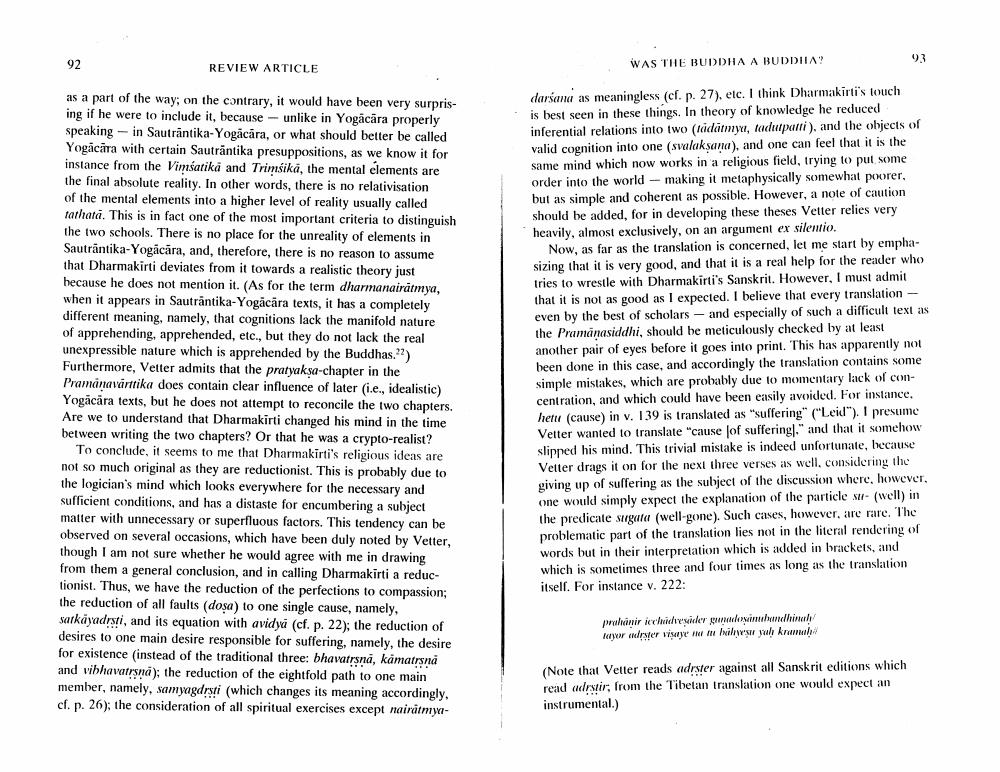Book Title: was The Buddha A Buddha Author(s): Eli Franco Publisher: Eli Franco View full book textPage 7
________________ 93 92 REVIEW ARTICLE WAS THE BUDDHA A BUDDHIA? as a part of the way, on the contrary, it would have been very surprising if he were to include it, because - unlike in Yogacara properly speaking - in Sautrantika-Yogācāra, or what should better be called Yogācāra with certain Sautrāntika presuppositions, as we know it for instance from the Vimšatika and Trimsika, the mental elements are the final absolute reality. In other words, there is no relativisation of the mental elements into a higher level of reality usually called tathat. This is in fact one of the most important criteria to distinguish the two schools. There is no place for the unreality of elements in Sauträntika-Yogācāra, and, therefore, there is no reason to assume that Dharmakirti deviates from it towards a realistic theory just because he does not mention it. (As for the term dharmanairatmya, when it appears in Sautrāntika-Yogacara texts, it has a completely different meaning, namely, that cognitions lack the manifold nature of apprehending, apprehended, etc., but they do not lack the real unexpressible nature which is apprehended by the Buddhas.") Furthermore, Vetter admits that the pratyakşa-chapter in the Praminavirttika does contain clear influence of later (i.e., idealistic) Yogacara texts, but he does not attempt to reconcile the two chapters. Are we to understand that Dharmakirti changed his mind in the time between writing the two chapters? Or that he was a crypto-realist? To conclude, it seems to me that Dharmakirti's religious ideas are not so much original as they are reductionist. This is probably due to the logician's mind which looks everywhere for the necessary and sufficient conditions, and has a distaste for encumbering a subject matter with unnecessary or superfluous factors. This tendency can be observed on several occasions, which have been duly noted by Vetter, though I am not sure whether he would agree with me in drawing from them a general conclusion, and in calling Dharmakirti a reductionist. Thus, we have the reduction of the perfections to compassion; the reduction of all faults (dosa) to one single cause, namely, sarkayadrsti, and its equation with avidya (cf. p. 22); the reduction of desires to one main desire responsible for suffering, namely, the desire for existence (instead of the traditional three: bhavatrsna, kamatrsna and vibhavatrsná); the reduction of the eightfold path to one main member, namely, samyagdrsti (which changes its meaning accordingly, cf. p. 26); the consideration of all spiritual exercises except nairinya darśana as meaningless (cf. p. 27), etc. I think Dharmakirti's touch is best seen in these things. In theory of knowledge he reduced inferential relations into two (tadarmya, tadurpalli), and the objects of valid cognition into one (svalaksana), and one can feel that it is the same mind which now works in a religious field, trying to put some order into the world - making it metaphysically somewhat poorer, but as simple and coherent as possible. However, a note of caution should be added, for in developing these theses Vetter relies very heavily, almost exclusively, on an argument ex silentio. Now, as far as the translation is concerned, let me start by emphasizing that it is very good, and that it is a real help for the reader who tries to wrestle with Dharmakirti's Sanskrit. However, I must admit that it is not as good as I expected. I believe that every translation - even by the best of scholars - and especially of such a difficult text as the Pramanasiddhi, should be meticulously checked by at least another pair of eyes before it goes into print. This has apparently not been done in this case, and accordingly the translation contains some simple mistakes, which are probably due to momentary lack of concentration, and which could have been easily avoided. For instance, hetu (cause) in v. 139 is translated as "suffering" (Leid"). I presume Vetter wanted to translate "cause of suffering." and that it somehow slipped his mind. This trivial mistake is indeed unfortunate, because Velter drags it on for the next three verses as well, considering the giving up of suffering as the subject of the discussion where, however, one would simply expect the explanation of the particle su-(well) in the predicale sugata (well-gone). Such cases, however, are rare. The problematic part of the translation lies not in the literal rendering of words but in their interpretation which is added in brackets, and which is sometimes three and four times as long as the translation itself. For instance v. 222: planir ichidhesideradoxinuhundhinah layer erster wisayer i Iniesu puhkrum (Note that Vetter reads adrster against all Sanskrit editions which read arstir, from the Tibetan translation one would expect an instrumental.)Page Navigation
1 ... 5 6 7 8 9 10
